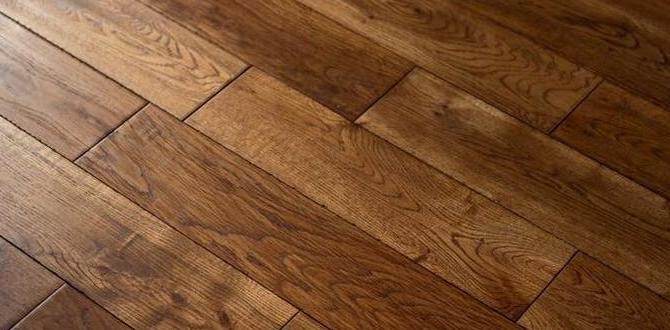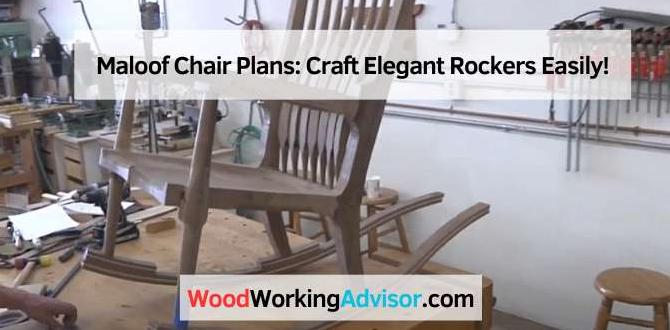Quick Summary: Elevate your DIY projects by discovering the top nail gun accessories. From air compressors and hoses to safety glasses and nail sets, these essential gear items boost efficiency, improve results, and ensure your safety. Get ready to nail your next project with the right tools!
Hey there, fellow DIYers and woodworkers! Jack Shaffer here from Nailerguy. Ever felt like your nail gun could do more, or maybe you’re just starting and wondering what else you really need besides the nail gun itself? It’s a common feeling, and often, the difference between a good project and a great one lies in a few smart accessories. Don’t worry, it’s not about buying a ton of stuff; it’s about getting the right stuff. We’ll walk through the top nail gun accessories that will make your jobs smoother, safer, and more professional. Let’s get your toolkit ready!
Table of Contents
Why Nail Gun Accessories Matter
Think of your nail gun like a talented chef. It can slice and dice, but it needs the right kitchen tools to perform at its best. Accessories aren’t just extras; they’re crucial components that enhance your nailer’s functionality, extend its lifespan, and, most importantly, keep you safe. Without the right supporting gear, you might face frustrating issues like inconsistent nail depth, damaged workpiece surfaces, or even safety risks. Investing in a few key accessories can turn those headaches into smooth sailing.
For beginners especially, understanding these accessories is the first step to mastering your nail gun and confidently taking on more ambitious projects. We’re going to break down what’s essential and why, so you can make informed decisions and get the most bang for your buck. Ready to upgrade your nail gun game?
The All-Important Power Source: Air Compressors & Power Sources
For most pneumatic nail guns (the most common type), an air compressor is the heart of the operation. It stores and delivers the compressed air your nailer needs to fire nails. Electric and battery-powered nailers have their own power sources, but for pneumatic users, this is your primary accessory.
Electric Air Compressors
Electric air compressors are powered by plugging into a standard electrical outlet. They are convenient for indoor use or anywhere with a reliable power source.
- Pros: Relatively quiet, no fumes, easy to operate, consistent power.
- Cons: Requires an electrical outlet, portability can be limited by cord length, some models can be heavy.
When choosing an electric compressor, look for a model with sufficient Cubic Feet per Minute (CFM) and PSI (pounds per square inch) ratings to match your nail gun’s requirements. A good starting point for most DIYers is a compressor with at least a 2-gallon tank and a 1.5 to 2.0 CFM rating at 90 PSI. For bigger jobs or framing nailers, you’ll need a larger tank and higher CFM output.
Gas-Powered Air Compressors
These are ideal for job sites without access to electricity. They run on gasoline and are generally more powerful but louder and produce exhaust fumes.
- Pros: Highly portable, powerful, ideal for remote locations.
- Cons: Noisy, produce exhaust fumes, require refueling, typically more expensive.
Battery-Powered and Cordless Nailers
These nailers have integrated batteries (like lithium-ion) that power a motor and a fan or a spring-loaded mechanism to drive nails. They offer ultimate portability and convenience, eliminating the need for air hoses or compressors.
- Pros: Unmatched portability, no hoses or compressors needed, quick setup, clean operation.
- Cons: Battery life limitations, can be heavier and more expensive upfront, sometimes less powerful than pneumatic counterparts for heavy-duty tasks.
If you’re tackling small to medium projects around the house and value speed and simplicity, a cordless nailer might be your best bet. For heavy-duty construction, pneumatic is often still the king, but cordless technology is rapidly improving.
Air Hoses & Connectors: The Lifeline
If you’re using a pneumatic nailer, the air hose is your direct link to the power source. The right hose and connectors ensure efficient airflow and prevent leaks.
Pneumatic Air Hoses
Air hoses come in various materials, lengths, and diameters. For DIY use, a 1/4-inch inner diameter hose is standard and suitable for most common nail guns. The length you need depends on your workspace and how far you’ll be moving around. A 25-foot hose is a good starting point, but 50-foot or even 100-foot hoses offer more freedom.
- Material:
- Rubber: Durable and flexible, good for all-around use.
- Polyurethane: Lighter and more flexible, especially in colder weather.
- PVC: More affordable but can be stiffer and more prone to cracking in cold.
- Length: Consider how much you need to move around your project. Too short can be restrictive; too long can be a tripping hazard and add weight.
- Diameter: A 1/4-inch ID is standard for most DIY nail guns. Larger diameters can allow for more airflow but may not be compatible with all nailers or compressors.
Air Couplers and Plugs
These are the fittings that connect your hose to the nail gun and the compressor. You’ll typically need a coupler for the hose end and plugs for both the hose and the nail gun. The most common type for DIY and professional use is the industrial “G” style coupler (often called a “T-style” coupler). Ensure you get the correct size and style for a secure, leak-free connection.
- Types: Industrial “G” style (most common), Aro, Lincoln, etc.
- Ease of Use: Look for couplers that are easy to connect and disconnect, especially when wearing gloves.
- Durability: Brass is a good material for durability and corrosion resistance.
A good tip is to have a few extra plugs and couplers handy. If one gets damaged or lost, you won’t be held up!
Safety First! Protecting Yourself and Your Work
Safety is paramount when using any power tool, and nail guns are no exception. These accessories are non-negotiable.
Safety Glasses/Goggles
This is your absolute, number one, must-have accessory. Flying debris, errant nails, or even just wood splinters can cause serious eye injury. Always wear safety glasses that meet ANSI Z87.1 standards. Goggles offer a bit more protection, especially in dusty environments.
- Features to look for:
- ANSI Z87.1+ Stamp: Ensures they meet impact resistance standards.
- Comfortable Fit: Look for padded nose bridges and temple arms.
- Scratch-Resistant Lenses: Keeps your vision clear for longer.
- Anti-Fog Coating: Essential if you’re working up a sweat or in humid conditions.
Hearing Protection
Nail guns, especially when combined with the noise of an air compressor, can reach levels that can damage your hearing over time. Earplugs or earmuffs are essential for protecting your ears. Earmuffs offer more comfort and a better seal in very noisy environments.
Gloves
Work gloves protect your hands from splinters, abrasions, and minor impacts. They also improve your grip on the nailer and the workpiece, leading to better control and fewer accidents. Look for gloves made of durable leather or synthetic materials.
Dust Masks or Respirators
When you’re cutting, sanding, or even just firing nails into certain types of wood (like MDF or treated lumber), you can create fine dust particles. Inhaling these can be harmful to your lungs. A simple disposable dust mask (N95 is a good standard) is usually sufficient for most DIY projects. For more significant dust or when working with hazardous materials, a half-face respirator might be necessary.
Enhancing Nailer Performance and Precision
These accessories help your nail gun perform better and make your finished work look cleaner.
Nail Sets
A nail set is a simple, metal tool used to sink nails slightly below the surface of the wood. This is critical for creating a smooth finish that can be easily filled and painted or stained. Many nail guns have an adjustable depth setting, but a nail set offers a manual backup and precision for those times when precise countersinking is needed, or when you’re dealing with tough hardwoods.
- How to use: Place the tip of the set on the nail head and tap gently with a hammer. Don’t hit too hard, or you’ll damage the wood.
- Types: Look for sets with a slightly rounded tip to center on the nail head.
No-Mar Tips
Many modern nail guns come with a “no-mar” or “non-marring” tip on the nose. If yours doesn’t, or if it’s worn out, it’s a great accessory to add. This soft rubber or plastic tip sits over the nail firing mechanism and prevents accidental marks or scratches on delicate surfaces like trim, pre-finished flooring, or softwoods like pine. It’s a lifesaver for achieving a pristine finish.
Swiveling Air Hoses Connectors
These small, inexpensive fittings attach between your air hose and the nail gun. They allow the hose to swivel freely in multiple directions, significantly reducing hose tangles and making it much easier to maneuver the nail gun in tight spaces or at awkward angles. If you’ve ever fought with a stiff, uncooperative air hose, you’ll appreciate the freedom a swivel connector provides.
Lubricant for Pneumatic Tools
Pneumatic nailers require lubrication to keep their internal mechanisms running smoothly and prevent excessive wear. Most compressors have an oil reservoir or an oiler that injects oil into the air stream. If your compressor doesn’t have an oiler, you’ll need to manually add a few drops of specialized pneumatic tool oil (often called “air tool oil”) to the tool’s air inlet before each use. This is crucial for extending the life of your nail gun.
- Frequency: Check your nail gun’s manual. Typically, a few drops before each session or at the start of the day is recommended.
- Type of Oil: Use only oil specifically designed for pneumatic tools. Regular motor oil can damage the seals and O-rings.
Specialized Nail Gun Accessories
Depending on the projects you tackle, some more specialized accessories can be incredibly useful.
Collated Nail Magazines
While not technically an “accessory” that you buy separately to add to your nailer, the type of collation (how the nails are held together) is important. Nail guns are designed for specific collation angles (e.g., 21°, 28°, 30°, 34°), and you need to buy the correct nails for your gun. Sometimes, a specialty magazine might be available for different nail types or lengths, but this is less common for general DIYers.
Belt Hooks
If you’re a professional or find yourself frequently moving around a large job site, a belt hook that attaches to your nailer can be a game-changer. It allows you to hang the nail gun on your belt or a sturdy railing when not in use, keeping it accessible and preventing it from being dropped or misplaced.
Carrying Cases and Storage Solutions
To protect your investment and keep your workspace organized, a sturdy carrying case is a must. Many nail guns come with one, but if yours didn’t, or if it’s flimsy, consider a dedicated hard case for transport and storage. For cordless models, a good case is essential for housing the tool, batteries, and charger.
Choosing the Right Accessories: A Practical Approach
Navigating the world of accessories can seem overwhelming. Here’s a simple way to decide what you truly need:
- Assess Your Nailer Type: Are you using a pneumatic, electric, or battery-powered nailer? This will dictate your power source needs.
- Consider Your Projects: What kind of work do you do most often? Trim work, framing, decking, DIY crafts? This influences the type of nailer and accessories like no-mar tips or specific nail sizes.
- Prioritize Safety: Safety glasses, hearing protection, and gloves are always essential, regardless of your tool or project.
- Address Frustrations: Are you struggling with tangled hoses? Get a swivel connector. Are you marking up delicate surfaces? Invest in a no-mar tip or nail set.
- Read Your Tool’s Manual: It’s the best source for understanding what your specific nail gun requires for maintenance and optimal performance, like lubrication.
Accessory Checklist Table
Here’s a quick rundown of essential accessories and their primary benefits:
| Accessory | Primary Benefit | Best For |
|---|---|---|
| Air Compressor (Pneumatic) | Powers pneumatic nail guns | Users of pneumatic nailers |
| Air Hose & Connectors (Pneumatic) | Delivers air to nail gun; secure connections | Users of pneumatic nailers |
| Safety Glasses/Goggles | Eye protection | All nail gun users |
| Hearing Protection | Ear protection from noise | All nail gun users (especially with compressors) |
| Gloves | Hand protection, improved grip | All nail gun users |
| No-Mar Tips | Prevents surface damage | Trim, finishing, and delicate wood work |
| Nail Set | Precise nail countersinking | Finishing, trim work, achieving smooth surfaces |
| Swivel Hose Connector | Reduces tangles, improves maneuverability | Users of pneumatic nailers, especially in tight spaces |
| Pneumatic Tool Oil | Maintains internal nail gun parts | Users of pneumatic nailers |
Where to Find Reliable Tooling Information
When you’re looking to expand your toolkit or understand how tools work, consulting authoritative sources is a great practice. For general safety guidelines on power tools, the Occupational Safety and Health Administration (OSHA) provides comprehensive information to keep you safe on the job. For in-depth knowledge on woodworking techniques and tool usage, resources like university extension programs (e.g., through NALIT, which lists various construction education programs) or well-respected woodworking associations often offer excellent guides and safety tips. Always ensure your accessories meet industry standards, like ANSI safety certifications.
Frequently Asked Questions (FAQ)
What is the most essential nail gun accessory?
Without a doubt, safety glasses are the most essential accessory. Eye protection is non-negotiable for every single use of a nail gun to prevent serious injury.
Do I really need an air compressor for my nail gun?
If you have a pneumatic (air-powered) nail gun, then yes, an air compressor is absolutely necessary. It’s what provides the compressed air to drive the nails. Battery-powered and electric nailers do not require an air compressor.
How do I know what size air hose I need?
For most DIY nail guns, a 1/4-inch internal diameter (ID) hose is standard. The length depends on your workspace – 25 feet is a good starting point, but 50 feet offers more freedom for larger areas.
Are no-mar tips really necessary for trim work?
Yes, they are highly recommended for trim work and any project involving delicate or pre-finished surfaces. A no-mar tip prevents the metal nose of the nail gun from leaving unsightly dents and scratches on your material, ensuring a clean, professional finish.
How often should I lubricate my pneumatic nail gun?
Most pneumatic nail guns require a few drops of specialized air tool oil in the air inlet before each use or at the start of a work session. Always refer to your specific nail gun’s user manual for the manufacturer’s recommended lubrication schedule and type of oil.
Can I use any extension cord with my electric nail gun?
No, you need to use an extension cord that is rated for outdoor use (if applicable), has the correct gauge (thickness) to handle the power draw of your nail gun without overheating, and is the appropriate length. Check your nail gun’s manual for specific extension cord recommendations.
What’s the difference between a nail set and a nail punch?
A nail set has a slightly rounded, dimpled tip designed to catch the head of



